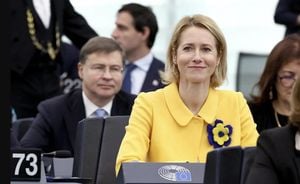Saydnaya prison, located just outside Damascus, Syria, has emerged as one of the most infamous embodiments of human rights violations during the long-lasting Syrian civil war. Reports suggest over 30,000 detainees have perished within its grim walls since conflict ignited in 2011, adding to the distressing total of more than 100,000 individuals believed to have disappeared under the regime of Bashar al-Assad.
Jeremy Bowen, reporting for BBC, vividly describes the atmosphere as he approached the prison. Despite the recent repainting of the entrance to reflect Syria's revolutionary flag colors, the facility exudes relentless dread and despair. Saydnaya, as Bowen notes, serves as the “dark and rotten heart of the regime,” where many were once held captive and silenced without ever returning home.
The Assad regime effectively utilized Saydnaya as part of its machinery of oppression, leveraging fear as a psychological weapon against the Syrian populace. The regime's sprawling intelligence network, coupled with routine torture and execution, ensured absolute subjugation. Unlike other prisons where some contact with the outside world is allowed, Saydnaya operated with complete isolation, amplifying the terror surrounding it.
Upon the prison's recent, albeit limited, accessibility, families of the disappeared flocked to the site, driven by the hope of finding answers. Jeremy Bowen observationally noted the chaotic scene, as these families sifted through abandoned paperwork scattered across the prison grounds, desperate to gather fragments of evidence related to their loved ones. Some were assessing the tattered remains of official documentation, portraying the efficient destruction attempted by the regime to erase its actions.
Volunteers like Safana Bakleh have taken it upon themselves to preserve these remnants of the past. With masks and gloves, they navigate the harsh environment, aiming to document the prison's brutal history. Safana articulated the emotional weight of this experience, declaring, “Even if one family gets one answer... it is enough for me.” Their accounts echo the collective trauma endured by families across Syria who continue to seek missing relatives.
Another volunteer, Widad Halabi, faced the grim reality of the conditions within Saydnaya, expressing disbelief at the suffering endured by detainees. “I can't believe people were living here when we were living and breathing our normal lives,” she said, her tears hinting at the depth of anguish felt upon witnessing the remnants of torture.
Justice looms as contentious ground for the Syrian populace. Many share the belief expressed by Hassan Abu Shwarb, who survived 11 years of torture following wrongful accusations of terrorism: “They should be punished. We are human souls, not stones after all.” Hassan’s words resonate with the collective desire for accountability from those who enforced such cruelty.
Outside the prison, the scene reflected struggles of displaced families seeking refuge from fear. Some had fled, believing their ties to the regime endangered them amid the lofty hopes of new beginnings. Others returned, hoping clinging to ghosts of their vanished kin. Yet overwhelming sentiments persist; families openly call for justice against those complicit, echoing Ahmed, who described Saydnaya prison as “a mass grave.”
The clandestine nature of Saydnaya's operations has led many to believe rumors of freezer trucks moving bodies from the prison to be credible. Mohammed Radwan, who continues searching for his brother and cousin detained since 2012, expressed outrage toward the regime. “Where did you, pig, take the 22 fridge trucks?” he demanded, insisting those involved should be held accountable. His frustrations leveled at Assad mirror those of countless others who wish to hold the perpetrators responsible.
Corruption was rampant within the Assad regime’s prison system, with individuals like Hassan detailing harrowing experiences where families had to pay exorbitant sums to avoid long sentences or secure releases. Reflecting on his ordeal, he recounted his family having to pay $50,000 across several attempts to extricate him from wrongful detainment, underscoring the catastrophic intersection of corruption and human suffering.
Despite the overwhelming grief faced by survivors and families of victims, hope exists for future healing. Though the road to justice may appear treacherous, the resolve to seek retribution against the regime indicates deep-rooted desires to reclaim humanity from decades of turmoil. The sentiment underscored by Hassan—“We need to forget and move on... All the sadness is behind us”—reveals the complex balance of remembrance and resilience needed to mend the nation.
Overall, Saydnaya prison's recent openness to investigation will likely serve as a pivotal moment for Syrian society as it navigates the complex aftermath of the Assad regime. The pursuit of justice intertwined with recognition of past atrocities will remain central themes as the nation embarks upon its uncertain path forward.



